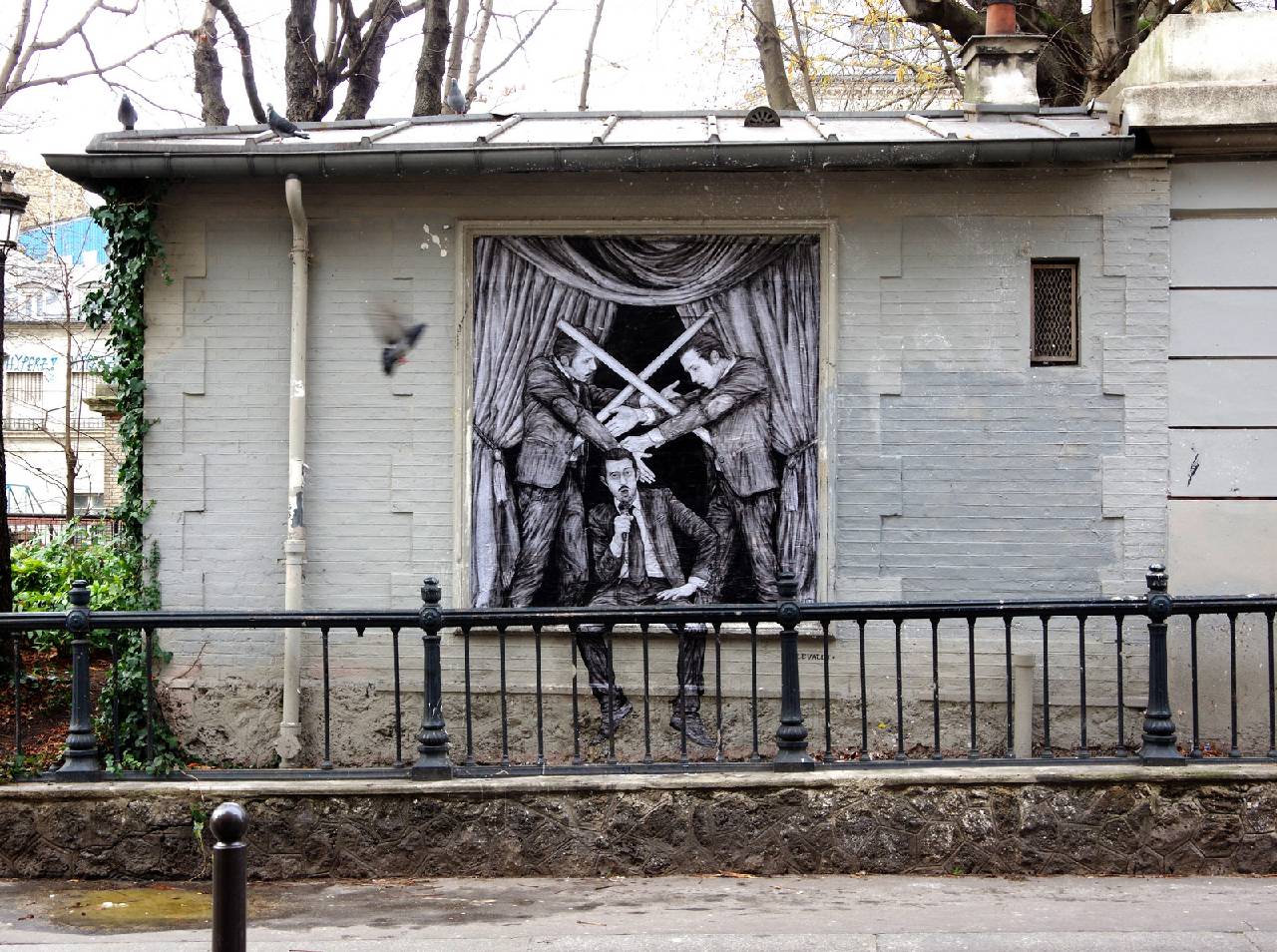
Levalet – Grand Guignol, Paris X, 2016- Image courtesy of the artist
When a discussion about the impact classical art has on modern movements takes place, rarely do street artworks come up as a natural topic. Usually, one would mention fine art painting or architecture as the best contemporary indicators of classical heritage, claiming that urban, bordering-on-illegal pieces are the diametrical opposite of any traditional art form. And that person would be completely right, at least to some extent. By the respected words of critics and experts, the definitive classical is perceived as a group of artworks that have adhered to artistic principles and rules laid down by centuries of contributions from master painters and sculptors whose artistic lineage leads all the way back to the noble Greeks and Romans, civilizations praised for their interpretation and formal representation of the human form and its environment. Just by reading the definition of what classical art is, it becomes clear that dynamic and rebellious street art has next to nothing to do with such concepts. Street art techniques like graffiti or stencil have very little connection with classical art, although the latter does have its origins found in an ancient method of primitive stenciling. Urban collage art is an automatic association with the classical aspect of the streets, but we should not forget that the medium of collage was, in fact, an avant-garde technique and as such was a direct opposite of traditional art. After considering everything street has to offer in this particular field, it seems that it should be perceived as a conceptual adversary to everything classical and that the two simply do not mix. However, the key word here is the term seems.
This is where street art’s versatility comes into play. When you base an art genre on a single restriction, which in this distinct case is only the location of where the piece is set, some practitioners will certalinly opt to take the medium down the more traditional road. Many adaptations are required in order to make the fundamental concepts of Classicism compatible with the basic necessities found in urban interventions, with some constraints being extremely incompatible with the traditional approaches to creating art. For example, quickness is a crucial aspect of street artworks, whilst the classical approach relishes the complete opposite procedure; provocation is often a goal in urban art, unlike the case is with the classic; the critical reflection of current social and political events is also popular for street expression and uncommon for classical art; the targeted audiences are completely different etc. This list can go on, proving that the differences are almost too restrictive for one to create a mix of these fields. Every artist that wanted to work in this elite circle of urban painting had to find a way of resolving the issues between the restless streets and harmonious Classicism. Keeping in mind that classic and street disciplines do not mesh in most areas, the individuals engaging in traditional forms of urban art focus on the only aspect that can be shared with the ancient techniques – the visuals. In achieving such hard demands and reaching the impressive level of aesthetics classic art is famed for, an urban interventionist can not rely on graffiti sprays, installations or stencils. Up until now, the most compatible technique in the street take on classical art has been the method of paste-ups – a technique in which an artist creates highly detailed art drawing pieces and later glues them on the chosen urban location. This is the only way of staying true to both the quick and illegal heritage of street pieces without compromising the harmonious visual norms of classical art drawing.
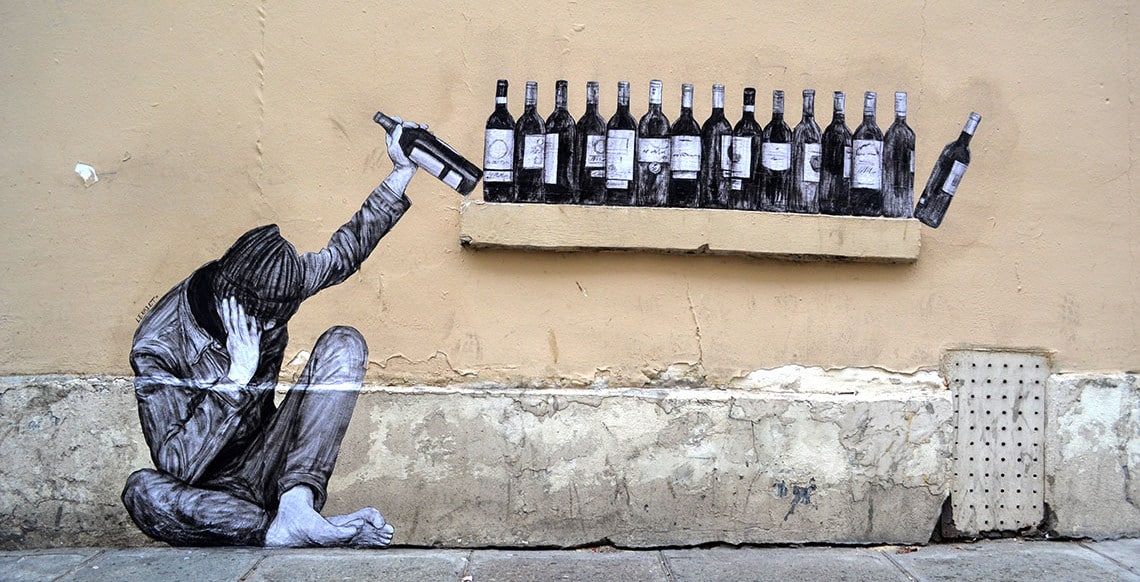
Levalet – Street Art Celle de Trop – Image courtesy of the artist
Ernest Pignon-Ernest ∙ The Legend of Classical Street Art
An instant association when you mention classical art drawing in the street, the work of Ernest Pignon-Ernest is as close to this idea, as urban art is capable of being traditional. This French painter has been enjoying a cult status for a couple of decades already and his street artworks are some of the most unusual pieces 20th century has to offer. Ever since the mid-1960s, Ernest Pignon-Ernest could be seen roaming the streets of Paris, wheat pasting his unique monochromatic artworks which would carry inside them strong political and social commentaries concerning the current state of France. Besides being impressive due to the early time period in which the urban interventions were far from a popular and established practice, Pignon-Ernest seems to be a textbook example of a street artist, almost too usual from today’s standpoint. However, what makes Pignon-Ernest stand out from literally every other fellow street painter are his unbelievably magical visuals based on classical art.
As it was already mentioned, Ernest mostly based his artworks on political views and that did not really change at any point of his career, even back when he was still experimenting. When Pignon-Ernest was starting to emerge, he wanted to channel his beliefs in a way that would make him a completely unique artist – his first street works were a direct reaction to France’s involvement in the nuclear strike on Hiroshima and Nagasaki, a notorious atom bombing that subsequently ended the World War II conflict. Back in the 1960s, the memory of the bloodiest war in the history of man was still too fresh for people to openly discuss some aspects of it, let alone the morally questionable nuclear attack on Hiroshima and Nagasaki. Pignon-Ernest desired to show his evaluation of France’s role concerning this event and made a decision to paint some of the most horrific street art drawing pieces to this day – imitating the dusted shadows on the walls left from people that were unfortunate enough to find themselves in the wrong place of Japan in August 1945, Ernest’s pieces were terrifying depictions of what these leftovers might have looked like.
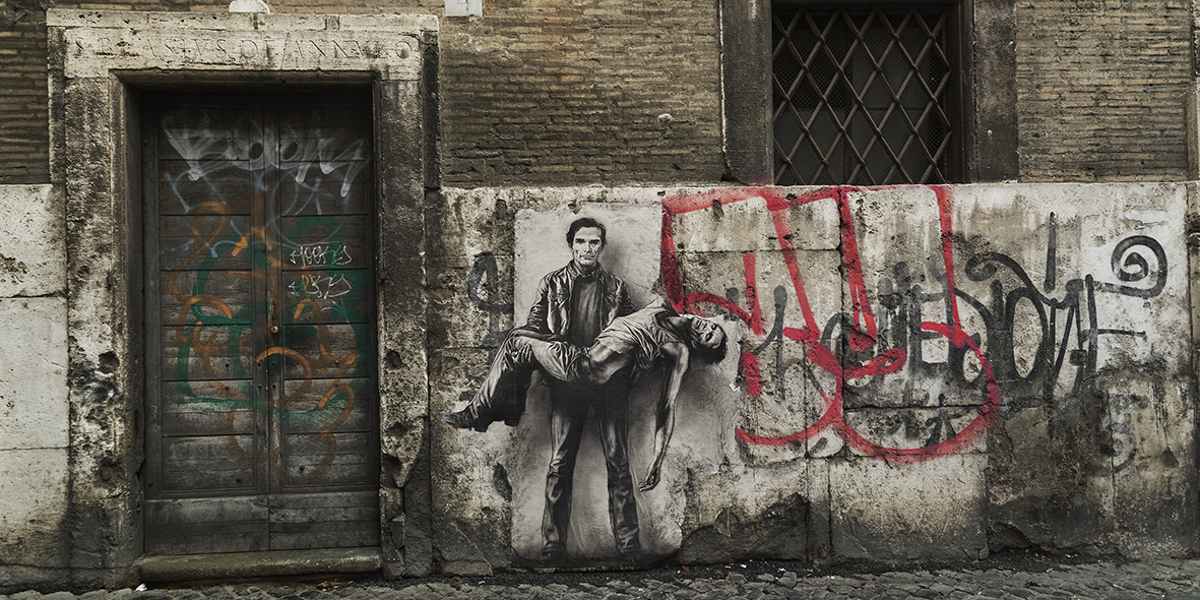
Ernest Pignon-Ernest – Pasolini, Rome, 2015 – Image via pignon-ernest.com
The Hiroshima and Nagasaki depictions were not as close to Classicism as mature works of Ernest will prove to be, but they did set a tone for what kind of artist he aimed to be in the future. This is because he was still searching for his style and norms, despite acting as if he was sure of himself and in control of his art. In the early days, Ernest-Pignon wanted to follow in the footsteps of Pablo Picasso – this is definitely due to a young man’s envy as the legendary Spanish painter of Cubism brought so many innovations to the world of art that Ernest wanted to make the same impact. Ultimately, he realized that following Picasso’s example meant he would be required to part ways with his own ideas and compromise the visual concepts behind his work – this was the moment Ernest set his sights on Classicism, forsaking the square and angles of the Cubists. The long lost and ignored visuals behind this 18th-century movement were forgotten in a world that only appreciated avant-garde artists and abstraction – keeping that in mind, Ernest took it even further as he was about to implement this movement’s ideas with the concepts of street art, which was completely bizarre to the public. Pignon-Ernest would additionally mix the concepts of French Fluxus and Situationism within his art, making his works even more unique. In achieving the desired results, he decided to use the technique of the wheat paste – a method in which a gel or liquid adhesive made from wheat flour or starch and water is used to hold posters and notices to walls. This would serve him well as making images of such advanced skill requirements were certainly not possible to make on sight – through wheat paste, Ernest was able to slowly and patiently create the pieces in a studio and then later glue them to a chosen urban location.
For the next few decades, he would work around Europe, creating pieces of unparalleled beauty – the street artworks still have no worthy rival capable of coming even close to Ernest Pignon-Ernest’s paste-ups. The subjects within his art were as if taken directly from a Renaissance cathedral or a Michelangelo sculpture – his human forms are full of volume, depth, masterful control over shadows, with facial expressions that can almost stand shoulder to shoulder with the paintings of Caravaggio. Besides being unique and simply gorgeous, Ernest’s paste-ups were also rather deep and allegorical. Always aiming to open the eyes of the spectator to look at misery, poverty, immigration, racism, epidemics and other difficulties of a selected place where chose to work, Pignon-Ernest brought to the surface forgotten histories, buried memories and politically informed remarks. This led him to establish a special kind of relationship with the locations where he would place his artworks – this important bond with architecture and contextualization of place and time became a large part of what Ernest was doing. By creating something completely his own and working through a mix of seemingly unblendable fields, Ernest took the audiences by storm and never truly let them go off the hook as his pieces are considered to be the most iconic ones in the history of street art. Although his output has logically declined, this artist is still active to this day, supporting the street scene both as a contributor and a theorist.
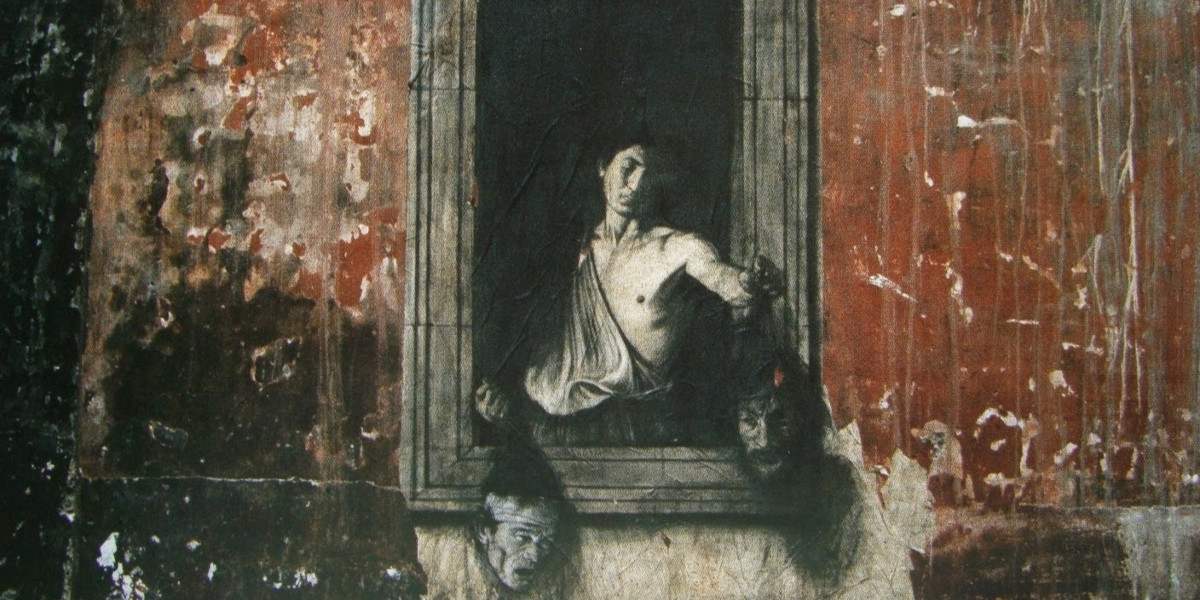
Ernest Pignon-Ernest – David et Goliath, 1988 – Image via pignon-ernest.com
How Classicism Exists Within Street Art Today
In recent decades, let alone years, it’s not easy to find classical art drawing elements within the field of street art. This is explained by the strong revolutionary accent placed on the urban authors that came as a product of establishing an entire socially accepted subculture of graffiti and anti-establishment opinions. Classicism has nothing to find within these circumstances, but the situation is not as dire as it was in the time of Pignon-Ernest when literally no one except him saw fit to experiment with traditional visuals and art drawing. Although not many of them, there are contemporary artists out there that have attempted to turn Classicism into the focal point of their urban interventions. And all of them have achieved this by utilizing the fine art drawing potential of paste-ups, as this method is clearly still the leading technique to anyone desiring to reach the level worthy of the classicistic title. Indeed, there are some draughtsmen who draw directly on the walls instead of pasting the images but, without denying that their compositions do look amazing, these artists have compromised the heritage of street art within their works. They substituted the quick and incognito nature of urban interventions with an approach that is much more traditional – basically, they’ve just swapped canvases for street locations. There’s no risk, there’s no sharpness, no rebellion – at least not the kind that lurked around Ernest’s name during his prime. For those reasons, we believe paste-ups are the perfect medium that unites both the classical and street-like features under one roof without compromising too much of their separate identities Artists who opt to use this method are able to put their art drawing skills on display AND still proudly claim that they are keeping the legacy of genuine street art well and alive.
Marco Battaglini
Italian artist Marco Battaglini introduces the classical paintings with the notions of street art in a completely new satirical way. Although his work may not be described best as artistic drawing, the amount of classical elements and traditional spirit this artist is able ti channel throughout his pieces makes him a necessity to any article concerning these kinds of topics. Hailing from Verona, a city famed for art, culture and the tragic love story of Romeo and Juliette, it comes as no surprise that Battaglini’s work is heavily influenced by the Renaissance’s takes on aesthetics and composition. His dramatic pieces wonderfully fuse together a wide range of genres, styles and references, combining the classical beauty with anti-aesthetic, literally blending the celestial with the vulgar. Battaglini’s work is a genuine interplay of different realities – he blends copycatted classic paintings with elements of pop culture and urban art, conjoining the classically portrayed central motifs with a modern street art background. Classicist figures such as goddesses, muses, angels and royals are often depicted with tattooed bodies and placed in front of the facades covered with graffiti art. All of Battaglini’s symbols are related to Western civilization, only referencing different time periods – this is ultimately the purpose of his art: remove barriers that distort the perception of reality. Each of his artworks offers a series of details that allow the observer to gradually discover secret meanings with a meticulous reading and a reflection on the dissolution by art free of the barriers of both time and space. Mixing elements of Michelangelo with the norms of Pop art established by Warhol and Lichtenstein, subsequently adding the touches of urban modern artists – we are pretty sure that one would have trouble finding a similar artist to Marco Battaglini.
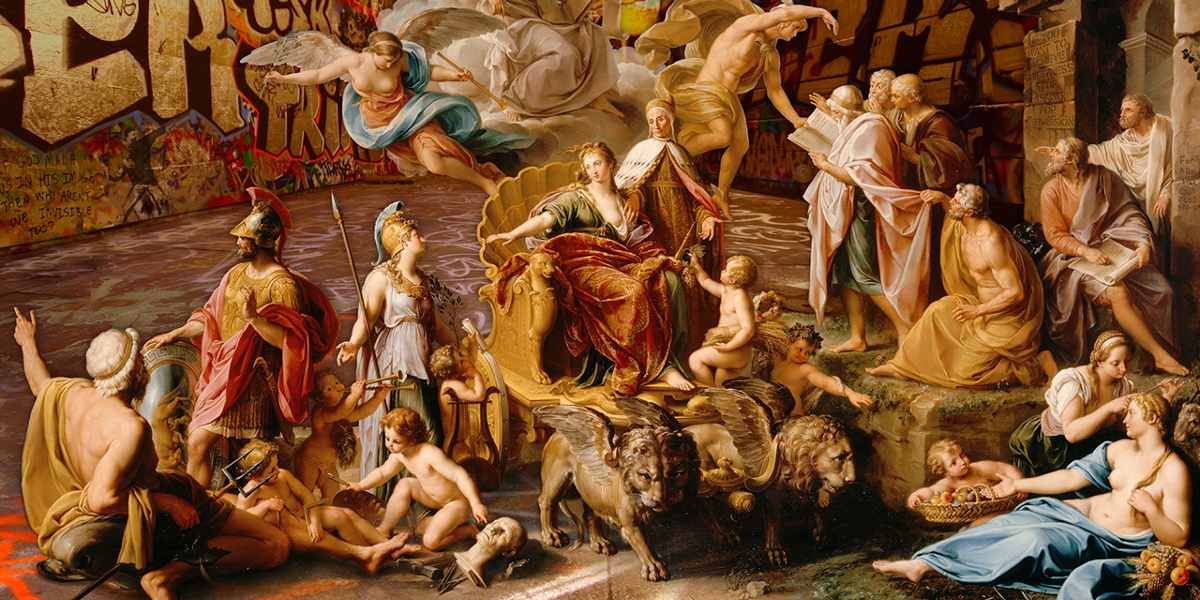
Marco Battaglini – Subtle Interplay – Image via mbattaglini.com
Julien de Casabianca
Julien de Casabianca is a former French journalist that became an artist and filmmaker, choosing to try and impact the world through a different strategy. By his own acclaim, Julien de Casabianca made the career-altering choice after a visit to the famed Louvre – whilst observing the legendary pieces of the most famous museum in the world, he saw a little girl portrayed in a forgotten corner of a painting, completely disregarded by the viewers who were all focusing on the piece’s centre. From that point on, Julien de Casabianca would attempt to help forgotten images like the little girl’s one to live a second life. The artist took a picture of her and later pasted her up on the street. He stayed true to the way she was originally painted and made sure her classic look remained intact. As he was finding more and more mistreated subjects in art history, Julien de Casabianca’ practice started to get more complex and advanced. Eventually, he believed that one man is not enough to make a difference – he called out for artists around the world, inviting them to turn characters from forgotten classical paintings into street art. This way, these subjects could get the renewed attention that they deserve. Julien de Casabianca even made a universal rulebook for anyone that desired to help him on his conquest of saving disregarded subjects of art history, defining with what and where the paste-ups will be placed, as well as organizing the adequate fees for anyone that wishes to contribute to his goals.
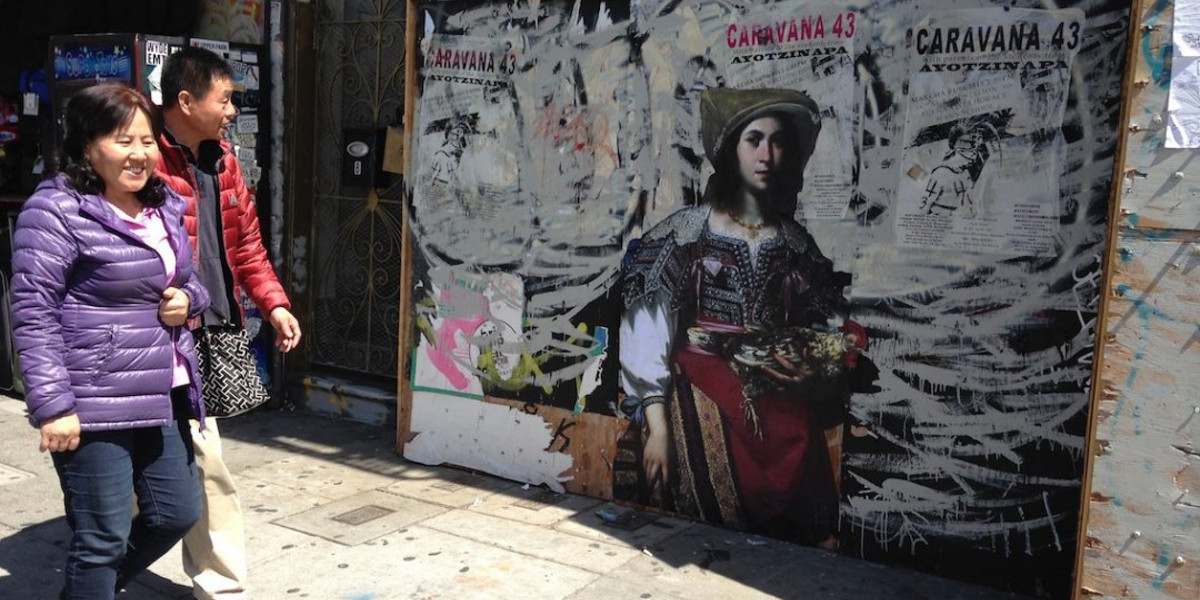
Julien de Casabianca – The Outings Project – Image via juliendecasabianca.com
Levalet
Arguably the closest thing the current street art scene has to a spiritual successor of Ernest Pignon-Ernest is Levalet. This Paris-based street artist created a fanbase both inside galleries and on the streets due to his wheat pasted collages and imagery that references the classic street artworks of the 80s, as well as continuing the legacy of Pignon-Ernest’s characteristic relationship between the piece and the location. Levalet takes advantage of Paris’ architecture and produces site-specific scenes with Indian ink art drawing. Through a talent blend expanding to the realms of theater and topography, Levalet’s art started out as a desire to create a sort of video installation compatible with the streets. This subsequently led him to an artistic goal of creating an interaction between the subject of the street artworks and the dimensions and features of the space they’re in, honoring the ideas of Pignon-Ernest and proving that urban art drawing is a legitimate part of the city’s identity – this not only connects Levalet with Ernest but also links him with the likes of Blek le Rat and Krzysztof Wodiczko. Choosing paste-up as his primary medium, Levalet turned to this collage-based principle because it allowed him to work with much more serious and challenging drawings than if he decided to operate with graffiti or stencils.

Levalet – Street Art Reload – Image courtesy of the artist
Surprisingly enough, the most impressive aspect of Levalet’s work is not its classical and realistic aesthetics, despite it being one of the most beautiful ones you will ever see – the definite focal point of his work is that the paste-ups totally integrate themselves into the urban landscape, leaving the impression that they are mere pieces of a jigsaw that were simply missing until now. The paste-ups complete the location, giving it a sense of meaning and producing an impression of an optical illusion through careful usage of staircases, house entrances or the ledges of buildings treated as a worthy element of his work, as necessary as the ink Levalet uses. His subjects follow the concept of fitting in with the place where they exist, arranging themselves so that they seem as hanging, leaning or sitting on the surfaces they are pasted on. This way, Levalet creates an entire triangle of interaction – the viewers observe as the pieces intercommunicate with the surroundings, while the street artworks lead two different kinds of conversations with both the location and the audience. Levalet’s gallery pieces are a bit different though as he seems more interested in exploring the DIY nature of his works whenever he operates within the confinements of a studio space.
Levalet’s work is always undertoned by a sense of humor as his paste-ups are cleverly placed on a chosen location to interact with the environment and ultimately give them a new context. After he has an idea, he makes preparatory sketches and then creates the designs that will serve as the basis for his drawings. The artist’s process is a prolonged one and it takes some time, but after the elaborate planning segment is over, he makes an art drawing of the figures in ink and glues them on their designated places around the city. Most of his subjects are black and white, an aspect that references the classical works of street art belonging to Ernest and Blek le Rat, the stencil king himself. Levalet’s classical drawing pieces are quite realistic as he does not seem comfortable with straying away into the realms of abstraction – in a way, his work is extremely honest and has a classical note of being exactly what it is, without burdening the piece with any unnecessary notions that would only diminish its playful style. His pieces are dynamic and depict everyday moments through paradox or aggravation. Levalet also incorporates three-dimensional objects within his pieces, a fact that led some to describe his work as urban installations – these mundane objects are usually books, pool cues, wine glasses or umbrellas.
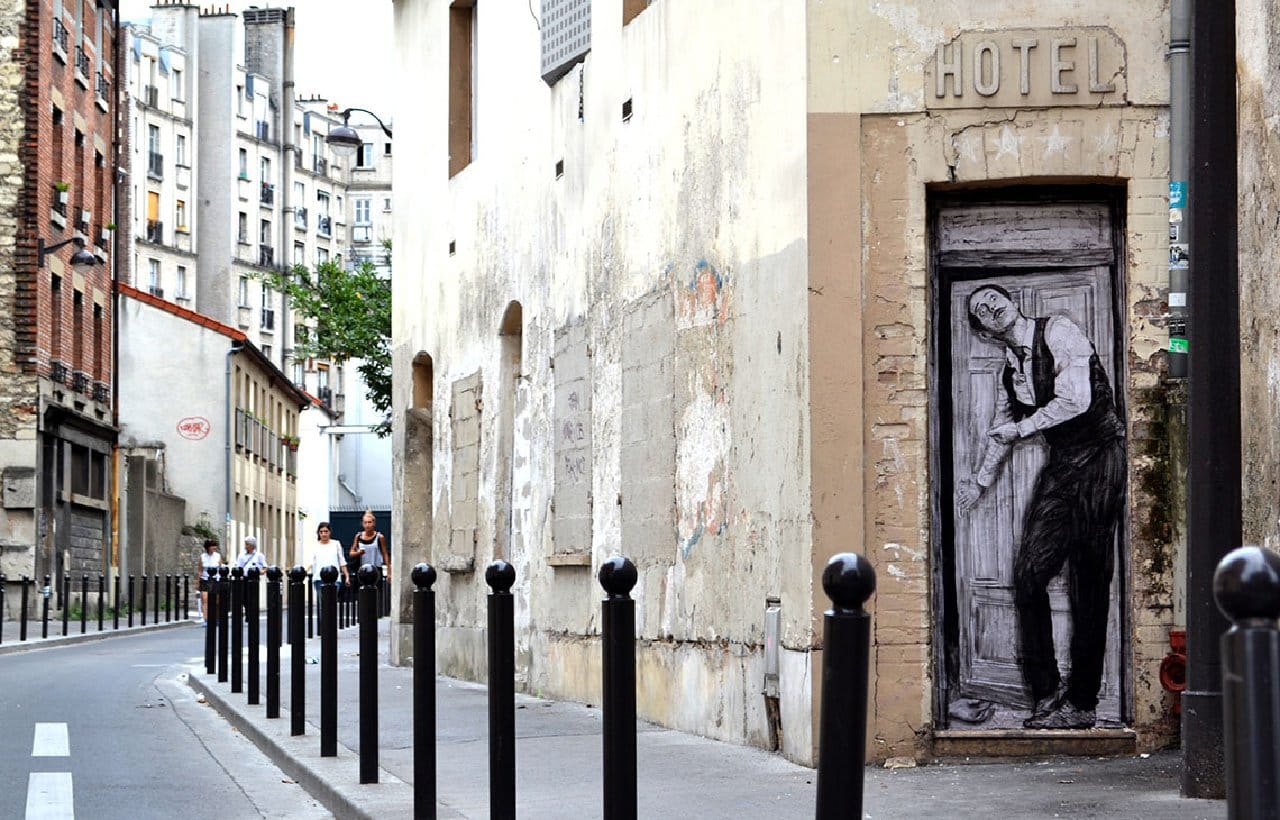
Levalet – Welcome, Paris XIX, 2015 – Courtesy of the artist
Is the Art Drawing in the Street Art Here to Stay?
Historically speaking, drawing is the primary means of artistic expression, so it comes as no surprise that it found a way to incorporate itself into all the variants of creation, including the world of street art. Its role will always be crucial, as all artists of all fields will draw from time to time, regardless of whether it represents the focal point of a piece or the planning section of it. However, when it comes to a particular combination of drawing within the street art that relies on classical norms and notions to create their visuals, the situation does seem a bit dire. There are frighteningly few artists that practice this kind of urban interventions, leaving a sense that the classical art drawing within the street medium is something that does not have a safe and rich future, if it does have one at all.
However, two facts make us optimistic when discussing what awaits the classical drawing on the streets in the following years and decades. First of all, ever since Ernest Pignon-Ernest started incorporating elements of traditional art drawing in his work, this subgenre of was never popular in a sense that other artists would actually take up the same method – his pieces were adored and respected but not imitated. This did not change to this day as the urban artists which use classical norms in their work are still an elite group whose outputs will always be appreciated by both fellow artists and the public, making sure that the few representatives of the genre never fall off track. This means that classical street art has already proven that it can survive despite not many painters practicing it. Another factor that makes us feel secure when it comes to classical heritage in urban art is that young forces choosing to work in this style have immense talent – Levalet is the obvious successor of classical in street art and it seems as though it found a safe place within the hands of this Paris-based draughtsman and paste-up maker. As long as there are fresh and talented minds to push the subgenre forward, the style’s safety can never be truly compromised. In fact, the previous statement successfully ties this elite drawing technique with all the predecessors built upon the norms of Classicism – quantity should never come before quality.
Written by Andreja Velimirović